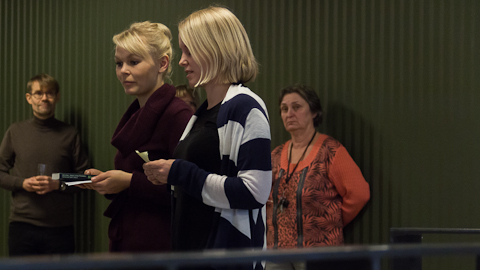Memory Boxes Offers New Way to Approach History
The book that opens up the concept of the memory box is an international cooperation between the Department of Cultural History at the University of Turku and the department of historical cultural sciences at the Johannes Gutenberg University Mainz.

Editors Heta Aali (left) and Anna-Leena Perämäki present their new book in the Janus lobby.
This year, the Faculty of Humanities has started organising Tiedepysäkki events which present the publications of the researchers of humanities at the University and aim to improve the flow of information between the different departments of the faculty.
In the last event of the year on Wednesday, 19 November, two new publications were presented: Hanna Meretoja’s The Narrative Turn in Fiction and Theory. The Crisis and Return of Storytelling from Robbe-Grillet to Tournier and a collection of articles titled Memory Boxes. An Experimental Approach to Cultural Transfer in History 1500–2000 edited by Heta Aali, Anna-Leena Perämäki and Cathleen Sart. Both books have their roots in the tradition of social constructionism.
In Meretoja’s book The Narrative Turn in Fiction and Theory, the concept of narrative turn, which is familiar from human sciences, is applied to the French prose literature after the Second World War. Alain Robbe-Grillet symbolises of the low point of the traditional narrative as the central theorist of noveau roman and metafiction whereas Michel Tournier’s work represents the backlash of the narrative. According to the author, the book is a new theoretical opening into narrative hermeneutics.
Memory Box Transfers Meanings in Time
Article collection Memory Boxes is the product of international co-operation and edited by Heta Aali, Anna-Leena Perämäki and Cathleen Sart.
–The idea for the book started from the collaboration project led by Hannu Salmi from the Department of Cultural History at the University of Turku and Jörg Rogge from the department of historical cultural sciences at the German Johannes Gutenberg University Mainz. The project included especially doctoral candidates from both departments, explains Anna-Leena Perämäki about the origin of the book.
The book expands Bernd Roeck’s memory box concept on cultural transfer by adding the examination of the temporal scope. The theoretical base for the book was founded by German researchers. In addition to Roeck, Egyptologist Jan Assmann’s research on cultural memory is one of the most central theoretical starting points of the book.
– Memory boxes are understood as cultural constructions that are part of the process of creating and challenging memory and memories. They are also important mediators of cultural transfer from one place and time to another. The memory box concept facilitates the study of the processes of cultural transfer, says Perämäki.
Memory Boxes is not a brick of a book on research and theory but a collection of articles with a new point of view. Perämäki says that it offers a practical approach to cultural transfer by examining the topic from many different points of view-
– The articles cover different points in time all the way from the 1500s to the 21st century. Cultural transfer and memory are discussed with case studies from Scotland to Italy and Germany as well as from Finland to France and the American colonies.
Text and photo: Heikki Kettunen
Translation: Mari Ratia